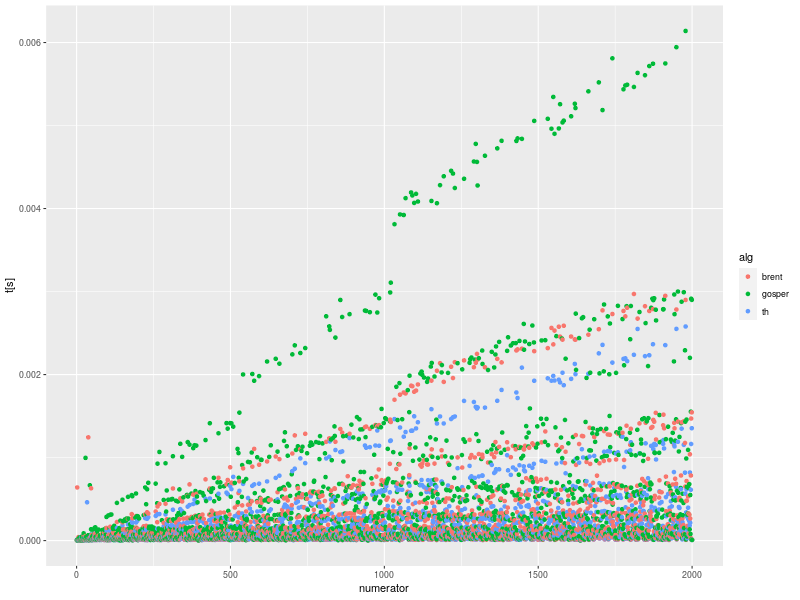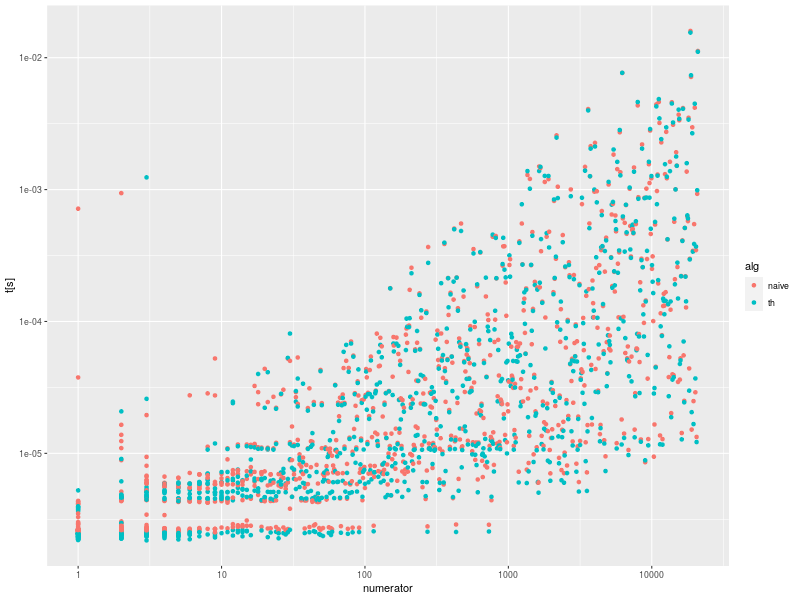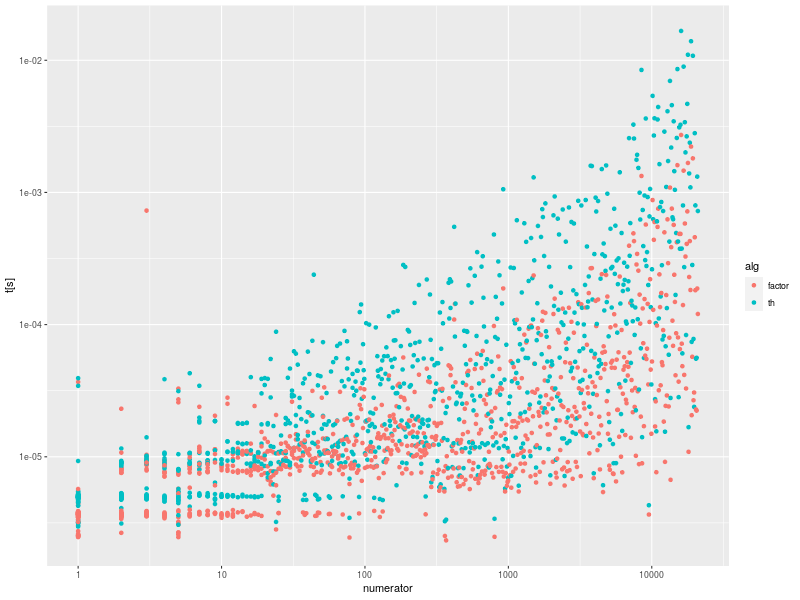ふと、有理数 n/d を循環小数に変換するメソッドを書いてみた
これを行うには、x_{i+1} = (10 * x_i) % d という漸化式で 定義される数列が、どこで cycle するかを検出しなければならない
x_i は d 未満の非負整数なので、状態数が有限であるため、かならずどこかで cycle が起きる
なお、数列の最初のあたりは cycle にならないことがある
x_0 から x_{h-1} は cycle に含まれず、 x_h から x_{h+l-1} が最初の cycle とすると、 h と l を求める、というのが cycle を検出する、という話である
これを行うにはいくつかのアルゴリズムがあるが、 wikipedia の Cycle detection にのっている、 兎と亀のアルゴリズム、 Brent のアルゴリズム、 Gosper のアルゴリズムというのを使って実装してみた
- 兎と亀のアルゴリズムは英語の説明を読んで、自分で真面目に (Wikipedia に載っている Python のコードは見ないで) 実装した
- Brent のアルゴリズムは Wikipedia に載っている Python のコードを Ruby に翻訳しただけ
- Gosper のアルゴリズムは HAKMEM の C のコードを Ruby に翻訳したが、 これは h の正確な値を求めてくれないので、そこは自分で実装した
なお、Hare というのが野うさぎらしい (亀は Tortoise)
兎と亀のアルゴリズムおよび Brent のアルゴリズムは実行中に数列の要素を 2つしか保持しないのに対し、 Gosper のアルゴリズムは log くらいの要素を保持する。 たくさん保持するぶん、cycle を速やかに検出することが期待されるので速いのではないかと思ったのだが... 後述
# recurring-decimal.rb
class Rational
# uses Floyd's Tortoise and Hare
def to_dec_th
sign = self < 0 ? "-" : ""
n = self.numerator.abs
d = self.denominator
int, mod = n.divmod(d)
s = "#{sign}#{int}"
return s if mod == 0
# There are fractional digits.
#
# If the fractional digits is recurring,
# it begins with non-recurring part of length h and
# recurring part of length l.
# foobarbazbazbaz... = foobar(baz) : h = 6, l = 3
#
# We have a sequence
# x0 = mod
# x1 = (x0 * 10) % d
# ...
# x{i+1} = (xi * 10) % d
# ...
#
# Since this sequence repeats from xh,
# xj = x{j+k*l} for all j >= h and k >= 0.
# At first, we find some i such that xi = x{2i}.
# However, we don't use i itself.
# i = 0
m1 = m2 = mod
begin
m1 = (m1 * 10) % d
# i += 1
m2 = (m2 * 10) % d
m2 = (m2 * 10) % d
end while m1 != m2
# We found i such that xi = x{2i}
# The difference of i and 2i is a multiple of the cycle length, l.
# 2i - i = i = k * l for some k.
# Then, we detect h.
# We search h from 0 to detect xh = x{h+k*l} = x{h+i}.
f = ""
h = 0
m1 = mod
while m1 != m2
d1, m1 = (m1 * 10).divmod(d)
f << d1.to_s
m2 = (m2 * 10) % d
h += 1
end
# If m2 is zero, the number is not recurring.
return "#{s}.#{f}" if m2 == 0
# At last, we find the recurring part.
l = 0
f << "("
m2 = m1
begin
d1, m1 = (m1 * 10).divmod(d)
f << d1.to_s
l += 1
end while m1 != m2
f << ")"
"#{s}.#{f}"
end
# uses Gosper's loop detector
def to_dec_gosper
sign = self < 0 ? "-" : ""
n = self.numerator.abs
d = self.denominator
int, mod = n.divmod(d)
s = "#{sign}#{int}"
return s if mod == 0
f = ""
# Gosper's loop detector
# https://web.archive.org/web/20160414011322/http://hackersdelight.org/hdcodetxt/loopdet.c.txt
x0 = mod
ms = [x0]
x = x0
n = 1
while true
digit, x = (x * 10).divmod(d)
f << digit.to_s
return "#{s}.#{f}" if x == 0
break if k = ms.index(x)
n +=1
j = (n & ~(n - 1)).bit_length - 1
ms[j] = x
end
m = ((((n >> k) - 1) | 1) << k) - 1;
l = n - m;
lgl = (l - 1).bit_length - 1
h_lo = m - [1, 1 << lgl].max + 1;
# Now, we have the length of the recurring part, l, and
# a lower bound of the length of the non-recurring part, h_lo.
# find the exact length of the non-recurring part, h.
# At first, find an element before the recurring part.
# Any element works well but we find maximum one already computed.
m0 = nil
k0 = nil
ms.each_index {|k2|
m2 = ((((n >> k2) - 1) | 1) << k2) - 1;
next if h_lo < m2
if m0 == nil || m0 < m2 then
k0 = k2
m0 = m2
end
}
if m0 then
h = m0
x1 = ms[k0]
else
h = 0
x1 = x0
end
# advance l times
x2 = x1
l.times {
x2 = (x2 * 10) % d
}
# find h.
while x1 != x2
h += 1
x1 = (x1 * 10) % d
x2 = (x2 * 10) % d
end
"#{s}.#{f[0, h]}(#{f[h,l]})"
end
end
# References:
# * Cycle detection
# https://en.wikipedia.org/wiki/Cycle_detection
# * HAKMEM ITEM 132 (Gosper): LOOP DETECTOR
# http://www.inwap.com/pdp10/hbaker/hakmem/flows.html
# * Gosper's loop detector implementation
# https://web.archive.org/web/20160414011322/http://hackersdelight.org/hdcodetxt/loopdet.c.txt
これを使うと、以下のように、有理数を十進の循環小数に 変換して、循環部分を括弧で括った文字列を得られる
(1/3r).to_dec_th #=> "0.(3)" (1/7r).to_dec_th #=> "0.(142857)" (22/7r).to_dec_th #=> "3.(142857)" (27/88r).to_dec_th #=> "0.306(81)"
循環しない小数で表現可能なら、括弧の部分はつかないようにしてある (0 が循環するとして "(0)" をつけてもいいのだが)
(1/5r).to_dec_th #=> "0.2"
とりあえず、以下のようにして 3個のメソッドが同じ結果になることを確認した (なんとなく、各分母に対して分子は乱数にしてみた)
% ruby -r./recurring-decimal.rb -e '
1.upto(20000) {|i|
r = rand(i).to_r/i
s1 = r.to_dec_th
s2 = r.to_dec_brent
s3 = r.to_dec_gosper
raise if s1 != s2 || s1 != s3
}
'
せっかく同じ動作をするメソッドを 3個も実装したので、 速度を測ってみよう
まずは平均から
% ruby -r./recurring-decimal.rb -e '
acc_a, acc_b, acc_c = 0.0, 0.0, 0.0
n = 2000
1.upto(n) {|i|
r = rand(i).to_r/i
t1 = Process.clock_gettime(Process::CLOCK_THREAD_CPUTIME_ID)
s1 = r.to_dec_th
t2 = Process.clock_gettime(Process::CLOCK_THREAD_CPUTIME_ID)
s2 = r.to_dec_brent
t3 = Process.clock_gettime(Process::CLOCK_THREAD_CPUTIME_ID)
s3 = r.to_dec_gosper
t4 = Process.clock_gettime(Process::CLOCK_THREAD_CPUTIME_ID)
acc_a += t2 - t1
acc_b += t3 - t2
acc_c += t4 - t3
}
printf("to_dec_th: %f\n", acc_a / n)
printf("to_dec_brent: %f\n", acc_b / n)
printf("to_dec_gosper: %f\n", acc_c / n)
'
to_dec_th: 0.000224
to_dec_brent: 0.000281
to_dec_gosper: 0.000567
うぅむ、いちばん素朴な兎と亀のアルゴリズムを使ったもの (to_dec_th) がいちばん速くて、 いちばん凝った Gosper のアルゴリズムを使ったもの (to_dec_gosper) がいちばん遅い
生データをとってプロットしてみよう
% ruby -r./recurring-decimal.rb -e '
acc_a, acc_b, acc_c = 0.0, 0.0, 0.0
n = 2000
puts "numerator,t,alg\n"
1.upto(n) {|i|
r = rand(i).to_r/i
t1 = Process.clock_gettime(Process::CLOCK_THREAD_CPUTIME_ID)
s1 = r.to_dec_th
t2 = Process.clock_gettime(Process::CLOCK_THREAD_CPUTIME_ID)
s2 = r.to_dec_brent
t3 = Process.clock_gettime(Process::CLOCK_THREAD_CPUTIME_ID)
s3 = r.to_dec_gosper
t4 = Process.clock_gettime(Process::CLOCK_THREAD_CPUTIME_ID)
a = t2 - t1
b = t3 - t2
c = t4 - t3
printf "%d,%g,th\n", i, a
printf "%d,%g,brent\n", i, b
printf "%d,%g,gosper\n", i, c
}
' > recurring-decimal.csvrecurring-decimal.R:
library(ggplot2)
d <- read.csv("2020-07/recurring-decimal.csv")
p <- ggplot(d, aes(numerator, t)) +
geom_point(aes(colour = alg)) +
ylab("t[s]")
print(p)

三角形になっているのは、 分母が大きくなるほど小数点以下の桁数が長くなる可能性がある (分子によっては短くなることもある) のでそれはそうなるか、という感じ
時間がかかっているのは、to_dec_gosper が多くて、 次いで to_dec_brent が多い、 というのは平均と整合する
ということで、循環小数については難しいことはせず、素朴に兎と亀のアルゴリズムを使うのがよさそう
Gosper の loop detector は、 数列を最初から順に調べていき、 いくつかの (調べた範囲の log くらいの) 要素を残しておいて 新しい要素を得るたびにそれと同じものが残しておいた要素の中にあるかどうかを調べる
ここで残しておくのは、新しいほうは密に残しておいて、古いほうはまばらに残す
そのために、i 番目の要素は、i を 2進数で表現したときに下位に 0 がいくつ並んでいるかで 上書きする要素を決めていく
これを読んで思い出したのだが、これは昔自分でバックアップのために考えた仕掛けと同じだな
なお、下位に並んでいる 0 の数を返す関数は RULER 関数と呼ぶひとがいたらしい
素朴なほうがいいというなら 兎と亀のアルゴリズムよりも単純に、 途中結果をぜんぶ記録しておくのはどうか
class Rational
def to_dec_naive
sign = self < 0 ? "-" : ""
n = self.numerator.abs
d = self.denominator
int, mod = n.divmod(d)
s = "#{sign}#{int}"
return s if mod == 0
f = ""
visited = {}
begin
visited[mod] = visited.size
digit, mod = (mod * 10).divmod(d)
f << digit.to_s
return "#{s}.#{f}" if mod == 0
end until visited[mod]
i = visited[mod]
"#{s}.#{f[0,i]}(#{f[i..-1]})"
end
end
これは、途中結果をぜんぶ記録するので、循環がなかなか見つからないと、 メモリをたくさん消費してしまう
とりあえずランダムな入力に対して to_dec_th と結果を比較して結果が一致することは確認した
で、to_dec_th と実行時間を比較
% ruby -r./recurring-decimal.rb -e '
n = 1000
puts "numerator,t,alg\n"
1.upto(n) {|i|
n = (1.01 ** i).to_i
d = rand(n) + 1
r = rand(d).to_r/d
t0 = Process.clock_gettime(Process::CLOCK_THREAD_CPUTIME_ID)
s0 = r.to_dec_naive
t1 = Process.clock_gettime(Process::CLOCK_THREAD_CPUTIME_ID)
s1 = r.to_dec_th
t2 = Process.clock_gettime(Process::CLOCK_THREAD_CPUTIME_ID)
raise if s0 != s1
a = t1 - t0
b = t2 - t1
printf "%d,%g,naive\n", n, a
printf "%d,%g,th\n", n, b
}
' > recurring-decimal2.csv
今回は、分母も乱数にして、あと、その乱数の範囲を指数関数的に広げて、 大きな値も測定するようにしてみた
recurring-decimal2.R:
library(ggplot2)
d <- read.csv("2020-07/recurring-decimal2.csv")
p <- ggplot(d, aes(numerator, t)) +
geom_point(aes(colour = alg)) +
scale_x_log10() +
scale_y_log10("t[s]")
print(p)

まぁ、to_dec_naive と to_dec_th は速度は同じくらいかな
